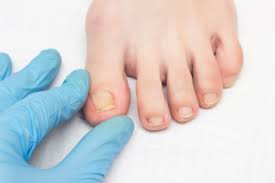Unveiling Onychogryphosis: Causes, Symptoms, and Treatment
When it comes to nail disorders, onychogryphosis stands as a distinct and often misunderstood condition. This comprehensive guide aims to shed light on the intricacies of onychogryphosis, from its unique symptoms and potential causes to the array of treatment options available. By delving into this wealth of knowledge, we embark on a journey to demystify onychogryphosis and empower individuals with the information they need to take control of their nail health.

Onychogryphosis Symptoms: Recognizing the Signs
Recognition is the first step towards effective management. Onychogryphosis, often referred to as “ram’s horn nails,” is characterized by a thickening and curving of the nails, resembling the shape of a ram’s horn. This abnormal curvature can lead to discomfort, pain, and difficulty in trimming and maintaining the nails. Discoloration and a distinct change in nail texture may also occur. By familiarizing ourselves with these telltale signs, we equip ourselves to identify onychogryphosis and seek timely intervention.
Onychogryphosis Causes: Unraveling the Factors
The origins of onychogryphosis are multifaceted. While it commonly affects the elderly, other factors come into play. Improper nail care practices, trauma to the nail, and underlying health conditions such as fungal infections and circulatory disorders can contribute to the development of this condition. Genetics and biomechanical factors also play a role. Understanding these potential triggers empowers us to adopt preventive measures and make informed decisions about treatment.
Diagnosing Onychogryphosis: Navigating the Evaluation
Accurate diagnosis is key to addressing onychogryphosis effectively. Healthcare professionals often diagnose this condition through visual examination. The distinctive curving and thickening of the nails, along with any associated discomfort, provide valuable diagnostic clues. In some cases, additional tests such as nail clippings for fungal cultures may be recommended to rule out underlying infections that could exacerbate the condition.
Differentiating onychogryphosis from other nail disorders is essential for tailoring the right treatment approach. Consulting a dermatologist or podiatrist ensures that you receive an accurate diagnosis and personalized guidance based on your unique condition.
Treatment Approaches: Managing Onychogryphosis
Managing onychogryphosis requires a multifaceted approach that considers both the physical and psychological aspects. For individuals with mild cases, at-home care can make a significant difference. Regular trimming, filing, and maintaining proper nail hygiene can help prevent excessive curving and thickening. Specialized nail clippers and emery boards designed for thick nails can assist in proper maintenance.
Living with Onychogryphosis: Coping and Managing
The impact of onychogryphosis goes beyond the physical, affecting emotional well-being and self-esteem. Individuals dealing with this condition might feel self-conscious or embarrassed about the appearance of their nails. It’s essential to remember that onychogryphosis is a medical condition, and seeking professional help is a positive step towards improvement.
Open communication with healthcare providers, family, and friends can provide much-needed support. Sharing your concerns and seeking guidance can alleviate the emotional burden associated with onychogryphosis. Engaging in self-care practices, mindfulness, and stress reduction techniques can contribute to a positive mindset as you manage the condition.
Future Perspectives: Research and Advancements
The field of dermatology and nail disorders is continuously evolving. Ongoing research endeavors are focused on understanding the underlying mechanisms of onychogryphosis and exploring innovative treatment approaches. As medical knowledge expands, new therapies and interventions may emerge, offering hope for improved outcomes.
Participating in clinical trials and staying informed about emerging treatments can be empowering. It’s essential to keep a watchful eye on advancements that could potentially revolutionize onychogryphosis management. As you navigate your journey, remember that staying informed is a proactive step towards improved nail health.
Frequently Asked Questions About Onychogryphosis
Q: What is onychogryphosis?
A: Onychogryphosis, also known as ram’s horn nails, is a nail disorder characterized by thickened and curved nails.
Q: What causes onychogryphosis?
A: Onychogryphosis can be caused by factors such as improper nail care, trauma, age, genetics, and underlying health conditions.
Q: What are the symptoms of onychogryphosis?
A: Symptoms include nails becoming curved, thickened, and discolored. Nails might resemble the shape of a ram’s horn.
Q: Is onychogryphosis painful?
A: Yes, onychogryphosis can cause pain and discomfort, especially when the curved nails press against the surrounding skin.
Q: Can onychogryphosis be treated at home?
A: Mild cases can be managed with regular nail trimming and filing at home. However, severe cases may require professional intervention.
Q: How is onychogryphosis diagnosed?
A: Diagnosis is often based on visual examination by a healthcare professional. In some cases, nail clippings may be analyzed for underlying issues.
Q: Can onychogryphosis affect self-esteem?
A: Yes, the appearance of curved and thickened nails might impact self-esteem. Seeking professional help and support can alleviate emotional concerns.
Q: What are the treatment options for onychogryphosis?
A: Treatment includes proper nail care, professional trimming, and addressing underlying causes. Dermatologists and podiatrists can provide guidance.
Q: Are there preventive measures for onychogryphosis?
A: Yes, maintaining proper nail hygiene, wearing comfortable footwear, and seeking timely treatment for nail issues can help prevent onychogryphosis.
Q: Can onychogryphosis recur after treatment?
A: Yes, onychogryphosis can recur if proper nail care is not maintained. Regular monitoring and follow-up appointments are essential.
Conclusion
As we conclude our exploration of onychogryphosis, we’ve journeyed through its symptoms, causes, treatment options, and the emotional aspects that accompany it. Armed with knowledge, you’re equipped to recognize the signs, seek professional intervention, and make informed decisions about your nail health.




